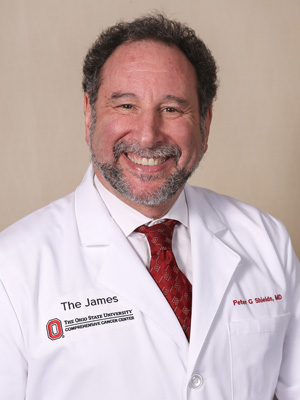Sept. 3, 2019:
 The Ohio State University has appointed Peter Shields, MD, to serve as the university’s representative on the Big Ten Cancer Research Consortium (Big Ten CRC) Steering Committee.
The Ohio State University has appointed Peter Shields, MD, to serve as the university’s representative on the Big Ten Cancer Research Consortium (Big Ten CRC) Steering Committee.
Dr. Shields, a thoracic medical oncologist and deputy director of The Ohio State University Comprehensive Cancer Center – Arthur G. James Cancer Hospital and Richard J. Solove Research Institute (OSUCCC – James), oversees the scientific research programs and research infrastructure of the OSUCCC-James, which includes more than 340 cancer researchers and their teams from 11 of Ohio State’s 15 colleges. His research focus and interests are in how cancer forms and how to prevent it, with an emphasis on developing tests to identify people who are at greatest risk of cancer.
Dr. Shields dedicates much of his oncology research toward breast and lung cancer, where he has researched the impact of tobacco products on the lungs and how alcohol consumption can cause breast cancer. He also is a professor of the College of Medicine and the College of Public Health at Ohio State. In the past, he has served as the president of the American Society of Preventive Oncology.
The OSUCCC – James is the only cancer program in the United States that features a National Cancer Institute (NCI)–designated comprehensive cancer center aligned with a nationally ranked academic medical center and a freestanding cancer hospital on the campus of one of the nation’s largest public universities.
As a founding member of the National Comprehensive Cancer Network (NCCN), the OSUCCC-James helps establish national guidelines and standards for cancer care. The cancer center is at the forefront of a multidisciplinary approach to cancer research and treatment that targets molecules and genetic markers to treat each person’s unique cancer with the goal of fewer side effects and better outcomes.
Through its depth of experience in oncology research, Dr. Shields said Ohio State researchers will contribute great value to the Big Ten CRC.
“We are an extremely high-volume cancer center; we put more than 1,200 patients a year on clinical trials,” Dr. Shields said. “We want to make sure we have trials for every patient that walks in.”
Dr. Shields said the collaboration between Big Ten CRC member institutions also adds value to each cancer center.
“The Big Ten CRC can be more nimble and get trials faster into the pipeline,” he said. “We can get clinical trials done quickly, so that’s attractive to pharma, as well as others. It also creates leadership opportunities for our junior investigators.”
Dr. Shields said oncology research is evolving and making revolutionary changes in how patients are treated, and he is grateful to see such progress during his career.
“The conversations we have with patients today are different than five years ago,” he said. “Most patients were just going on immunotherapy trials four and five years ago. It’s not uncommon now for patients to be living two years with Stage IV lung cancer on immunotherapy. What’s exciting is what could come down the pike – that these discoveries are now exponential. Again, we’re going to have different conversations with patients, with the hope that we will make cancer a chronic illness or cure it more often.”
About the Big Ten Cancer Research Consortium: The Big Ten Cancer Research Consortium was created in 2013 to transform the conduct of cancer research through collaborative, hypothesis-driven, highly translational oncology trials that leverage the scientific and clinical expertise of Big Ten universities. The goal of the Big Ten Cancer Research Consortium is to create a unique team-research culture to drive science rapidly from ideas to new approaches to cancer treatment. Within this innovative environment, today’s research leaders collaborate with and mentor the research leaders of tomorrow with the unified goal of improving the lives of all patients with cancer.
About the Big Ten Conference: The Big Ten Conference is an association of world-class universities whose member institutions share a common mission of research, graduate, professional and undergraduate teaching and public service. Founded in 1896, the Big Ten has sustained a comprehensive set of shared practices and policies that enforce the priority of academics in the lives of students competing in intercollegiate athletics and emphasize the values of integrity, fairness and competitiveness. The broad-based programs of the 14 Big Ten institutions will provide over $200 million in direct financial support to almost 9,500 students for more than 11,000 participation opportunities on 350 teams in 42 different sports. The Big Ten sponsors 28 official conference sports, 14 for men and 14 for women, including the addition of men’s ice hockey and men’s and women’s lacrosse since 2013. For more information, visit www.bigten.org.














Subscribe to the Big Ten CRC Newsletter X
X Facebook
Facebook YouTube
YouTube